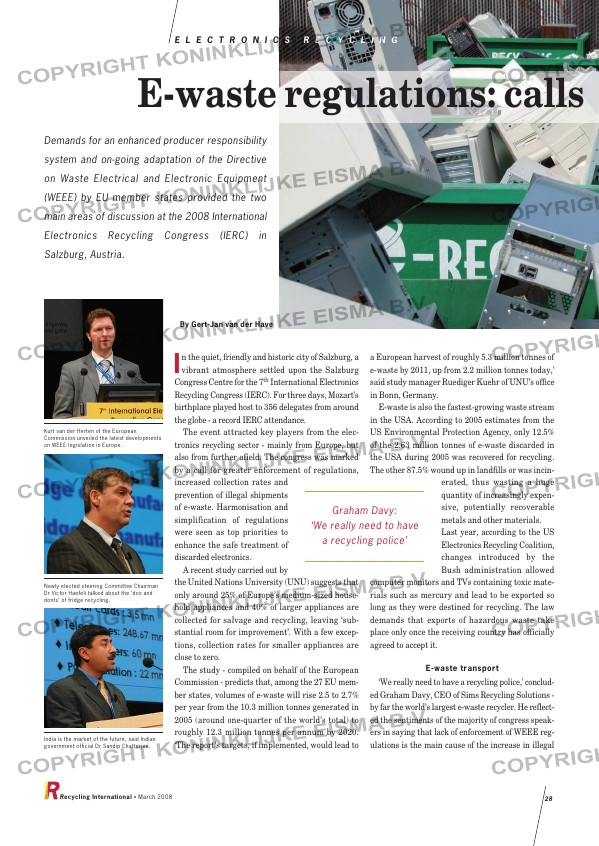Page 28 from: March 2008

In the quiet, friendly and historic city of Salzburg, avibrant atmosphere settled upon the Salzburg
Congress Centre for the 7th International Electronics
Recycling Congress (IERC). For three days, Mozart’s
birthplace played host to 356 delegates from around
the globe – a record IERC attendance.
The event attracted key players from the elec-
tronics recycling sector – mainly from Europe, but
also from further afield. The congress was marked
by a call for greater enforcement of regulations,
increased collection rates and
prevention of illegal shipments
of e-waste. Harmonisation and
simplification of regulations
were seen as top priorities to
enhance the safe treatment of
discarded electronics.
A recent study carried out by
the United Nations University (UNU) suggests that
only around 25% of Europe’s medium-sized house-
hold appliances and 40% of larger appliances are
collected for salvage and recycling, leaving ‘sub-
stantial room for improvement’. With a few excep-
tions, collection rates for smaller appliances are
close to zero.
The study – compiled on behalf of the European
Commission – predicts that, among the 27 EU mem-
ber states, volumes of e-waste will rise 2.5 to 2.7%
per year from the 10.3 million tonnes generated in
2005 (around one-quarter of the world’s total) to
roughly 12.3 million tonnes per annum by 2020.
‘The report’s targets, if implemented, would lead to
a European harvest of roughly 5.3 million tonnes of
e-waste by 2011, up from 2.2 million tonnes today,’
said study manager Ruediger Kuehr of UNU’s office
in Bonn, Germany.
E-waste is also the fastest-growing waste stream
in the USA. According to 2005 estimates from the
US Environmental Protection Agency, only 12.5%
of the 2.63 million tonnes of e-waste discarded in
the USA during 2005 was recovered for recycling.
The other 87.5% wound up in landfills or was incin-
erated, thus wasting a huge
quantity of increasingly expen-
sive, potentially recoverable
metals and other materials.
Last year, according to the US
Electronics Recycling Coalition,
changes introduced by the
Bush administration allowed
computer monitors and TVs containing toxic mate-
rials such as mercury and lead to be exported so
long as they were destined for recycling. The law
demands that exports of hazardous waste take
place only once the receiving country has officially
agreed to accept it.
E-waste transport
‘We really need to have a recycling police,’ conclud-
ed Graham Davy, CEO of Sims Recycling Solutions –
by far the world’s largest e-waste recycler. He reflect-
ed the sentiments of the majority of congress speak-
ers in saying that lack of enforcement of WEEE reg-
ulations is the main cause of the increase in illegal
Recycling International • March 2008 28
By Gert-Jan van der Have
Demands for an enhanced producer responsibility
system and on-going adaptation of the Directive
on Waste Electrical and Electronic Equipment
(WEEE) by EU member states provided the two
main areas of discussion at the 2008 International
Electronics Recycling Congress (IERC) in
Salzburg, Austria.
Kurt van der Herten of the European
Commission unveiled the latest developments
on WEEE legislation in Europe.
Newly elected steering Committee Chairman
Dr Victor Haefeli talked about the ‘dos and
donts’ of fridge recycling.
E L E C T R O N I C S R E C Y C L I N G
E-waste regulations: calls fo
Graham Davy:
‘We really need to have
a recycling police’
India is the market of the future, said Indian
government official Dr Sandip Chatterjee.
RI_008 Review IERC:Opmaak 1 28-02-2008 11:41 Pagina 28



